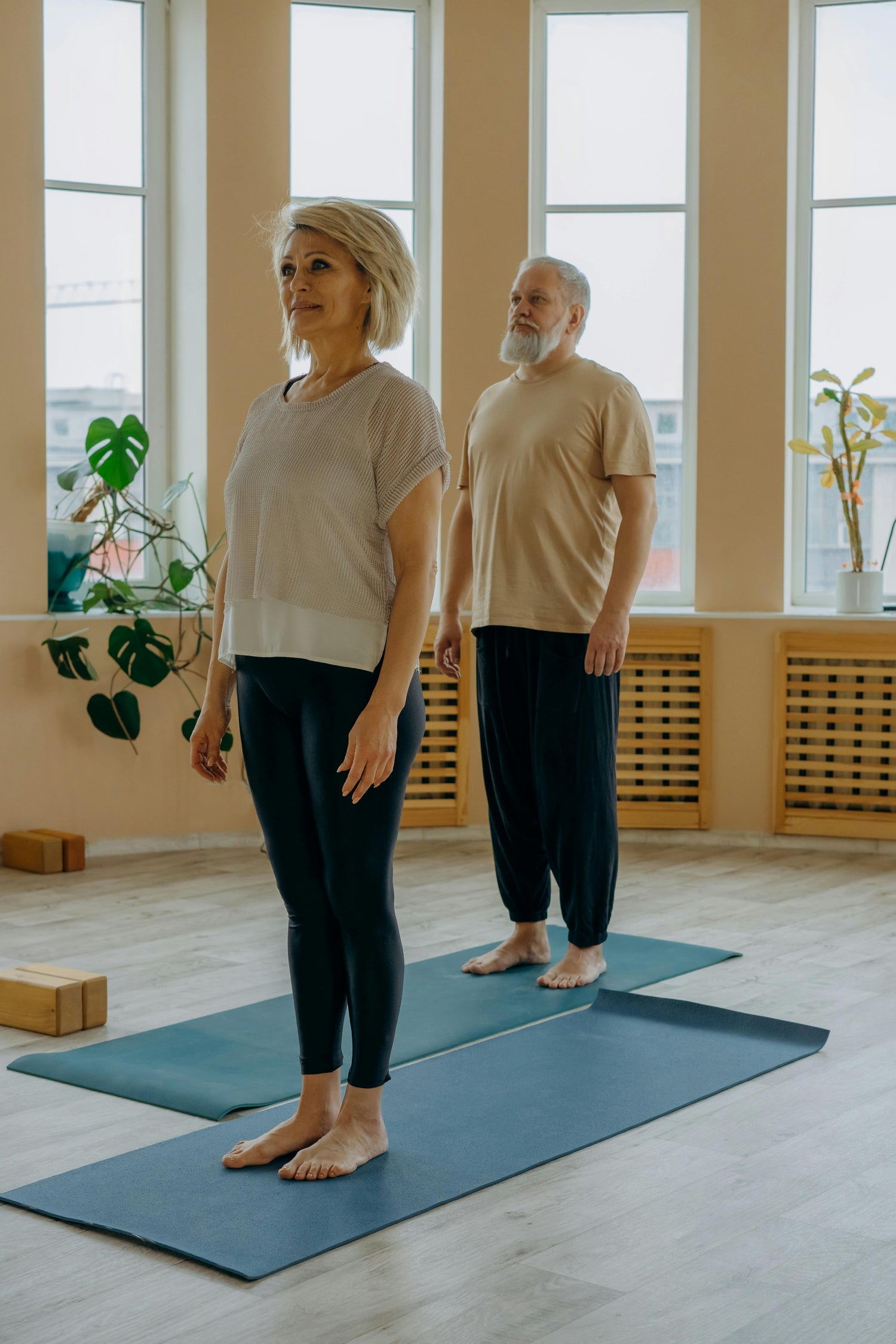YOGA AND NEUROSCIENCE : AN ALLIANCE FOR MENTAL WELL-BEING
Did you know that yoga, in addition to being a centuries-old practice, is now at the heart of neuroscientific discoveries? Discover how this discipline transforms our brain and improves our mental well-being.
Written by Valentine - January 2025
Collapsible content
Reading time
About 10 minutes
WHAT YOU ARE ABOUT TO DISCOVER
How neuroscience is proving yoga's impact on the brain , using technologies like functional MRI to explore its effects.
Why yoga promotes brain plasticity , allowing the brain to adapt and strengthen throughout life.
The role of yoga in stress management , by regulating the nervous system and calming emotional responses.
How yogic meditation affects brain waves , promoting a state of calm, creativity and concentration.
Why yoga benefits all generations , from children to seniors, by improving both cognitive abilities and mental resilience.
Concrete and inspiring examples , from research and initiatives around the globe, to better understand these benefits.
- "Let's take a look"!

YOGA: A MILLENNIAL-YEAR-OLD SCIENCE REVISITED
For millennia, yoga has been practiced as a holistic discipline, uniting body, mind and spirit.
But in 2025, neuroscience is shedding fascinating light on its tangible effects. Using cutting-edge technologies like functional magnetic resonance imaging (fMRI), researchers are discovering how yoga directly influences the structure and function of the brain.
Example 1: A study conducted by the University of California used fMRI to observe the brains of regular yoga practitioners. The results showed a significant increase in neural connectivity in the hippocampus, a key region for memory and emotion management.
Example 2: In Japan, scientists observed that meditators who practiced yoga daily had a notable reduction in activity in the amygdala, thereby decreasing stress responses.
Example 3: In France, a neuroscience laboratory integrated yoga classes into a program intended for the researchers themselves, showing an improvement in cognitive functions and better management of mental load.

YOGA AND BRAIN PLASTICITY: A BRAIN IN CONSTANT EVOLUTION
One of the key concepts revealed by neuroscience is neuroplasticity , the brain's ability to remodel itself based on our experiences.
Studies show that regular yoga and meditation practices can thicken key areas of the brain, including the prefrontal cortex, which is associated with decision-making and emotional regulation.
Example 1: In India, a yoga program for adolescents, combining postures and meditation, demonstrated a significant improvement in their ability to concentrate and solve problems, as measured by neuropsychological tests.
Example 2: In adults, a practice like Yin Yoga, where postures are held for a long time, has shown benefits on decision-making under pressure.
Example 3: A study conducted in London found that patients with neurological disorders, such as multiple sclerosis, who practiced yoga showed better brain plasticity, promoting functional recovery.

STRESS REDUCTION THROUGH THE BRAIN-BODY AXIS
Neuroscience confirms that yoga acts as a regulator of the parasympathetic nervous system , often called "the rest and digest system." By synchronizing breath with movement, yoga decreases activity in the amygdala, the brain region responsible for the stress response.
Example 1: Employees at a Silicon Valley company followed a three-month yoga program based on mindful breathing. The results showed a 25% decrease in their cortisol (stress hormone) levels, as measured by saliva samples.
Example 2: A hospital in Germany offers therapeutic yoga sessions to its patients with chronic illnesses, showing a 40% decrease in perceived stress levels after six weeks.
Example 3: In South Africa, community yoga programs in townships have helped reduce post-traumatic stress in young people exposed to violence by strengthening their capacity for emotional regulation.

BRAIN WAVES HARMONIZED BY YOGIC MEDITATION
Meditation, a key component of yoga, directly affects brain waves , promoting a state of deep relaxation. Recent research shows that regular meditators increase the production of alpha and theta waves, which are associated with creativity and a relaxed mental state.
Example 1: A neuroscience lab in Germany observed the brain waves of Kundalini meditation practitioners. The data showed a 50% increase in alpha waves after just 20 minutes of meditation.
Example 2: Yoga schools in India report that students who practice Pranayama (yogic breathing) see an improvement in their concentration thanks to the harmonization of gamma waves.
Example 3: In Australia, studies of artists practicing yoga show a notable increase in their theta waves, associated with improved creativity and innovative ideas.

A PRACTICE SUITABLE FOR ALL GENERATIONS
One of the great benefits of yoga is its universality.
In 2025, neuroscience shows how yoga can be beneficial at every stage of life.
In children, it improves attention and memory.
In adults, it strengthens emotional resilience and mental clarity.
Finally, for seniors, it slows cognitive decline, helping to prevent disorders such as dementia.
Example 1: In a school in Finland, a children's yoga program reduced hyperactivity by 40% and improved their attention in class.
Example 2: Among seniors in Toronto, weekly Hatha Yoga classes showed a 20% increase in performance on verbal memory tests after three months.
Example 3: In Asia, intergenerational yoga practices bring together children and grandparents, strengthening both the cognitive health of the elders and the emotional balance of the younger ones.

CONCLUSION: A DISCIPLINE AT THE CROSSROADS OF SCIENCE AND HUMANITY
In the era of scientific innovation, yoga retains its spiritual essence while being enriched by neuroscientific discoveries.
This alliance of tradition and science offers a unique opportunity to understand how ancient practices can reshape our brains and our modern lives.
Example 1: Whether in stressful urban environments like Tokyo or peaceful nature retreats, yoga continues to prove its ability to reconnect humans to their well-being, guided by an approach that is both intuitive and scientific.
Example 2: Companies like Google have incorporated yoga spaces and meditation programs for their employees, demonstrating reduced absenteeism and improved productivity.
Example 3: In Bali, yoga centers combine neuroscience and spirituality to offer a complete experience aimed at harmonizing mind and body.
Thanks for this news post!
HEALTHY MIND, HEALTHY LIFE
Valentine's Bio
-

VALENTINE
1994, Reunion Island, Mauritius, a Life carried by the Indian Ocean and Yoga
Since childhood, this intrepid traveler has traveled the globe, leaving her footprints on beaches around the world.Passionate about surfing, scuba diving and sailing, she has made the oceans her playground and source of inspiration.
The freedom of the waves, the serenity of the ocean depths and the wind in his sails have punctuated his journey, always guided by a quest for connection with nature.
It was through her explorations that yoga became more than a practice for her – it was a way of life.
Between early morning surf sessions and meditative sunsets, she found in yoga a perfect balance of strength, flow and self-awareness.
Today, she combines her passion for water sports with teaching yoga and is part of the Yogaterrae team, here in France, in the South West and often remotely :)
This adventurer is a true source of inspiration for anyone who aspires to live in harmony with their body and nature.
Through her stories of incredible experiences, she invites everyone to open up to a world where every wave, every breath and every posture is a celebration of life.



